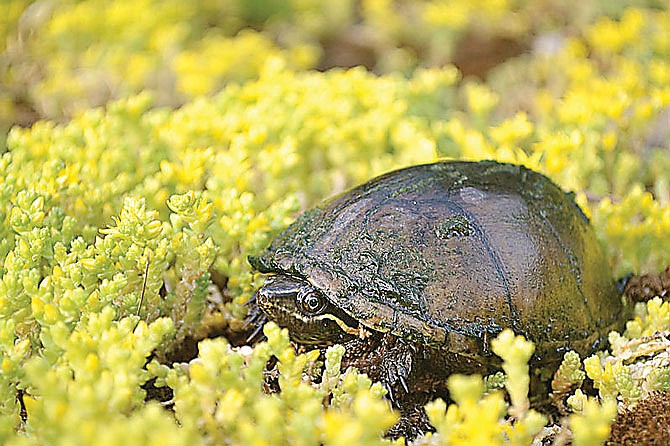The Eastern musk turtle (Sternotherus odoratus) isn't just an adorably tiny denizen of Missouri's rivers and ponds - though it certainly is that.
It's also a ferocious predator, a speedy swimmer and a real stinker.
"Some people call it a 'stinkpot,' but that's all in love, because I really do like these little turtles," said Missouri Department of Conservation naturalist Angela Pierce.
Pierce gave a virtual presentation on the turtles Tuesday. Stinkpots are found throughout southern and eastern Missouri. Though they haven't been officially documented in Callaway County, they've been found in nearby Miller, Maries, Franklin and Lincoln counties.
An Eastern musk turtle shares some characteristics with Missouri's other aquatic turtles.
Like all reptiles, it's ectothermic, or cold-blooded, meaning it can't regulate its body temperature. In the heat of summer, it seeks cool, deep water; on chilly days, it basks in the sunshine; and when winter arrives, it hibernates in the mud under bodies of water.
This also means it has a slow metabolism.
"They don't have to eat as much as we do," Pierce said.
All of Missouri's turtles lay their eggs on land, with Eastern musk turtles laying two to five eggs sometime between June and August. They hatch in early fall or - if laid late enough in the year - spend the winter underground and hatch in spring.
"These are small turtles to start with, so they're very tiny as hatchlings," Pierce said.
Also like other turtles, the Eastern musk turtle has a shell, which is grown from modified ribs.
"Despite the stories we may have heard growing up, turtles cannot leave their shells," Pierce said.
On Eastern musk turtles, the upper part of the shell (the carapace) is unusually domed compared to other aquatic turtles. On the lower shell, the plastron, the presence of a little divot reveals if the turtle is a male.
But a number of characteristics set Eastern musk turtles apart from Missouri's other turtles.
For one, they're the smallest turtle in Missouri. Even as an adult, their shell ranges from 2-4 inches long. Their faces have white or yellow stripes down the sides, and little barbels - like a catfish's whiskers - dangle from their chins.
They also possess musk glands, allowing them to give off a stinky scent when startled. These glands are located in the skin below the turtle's carapace.
Stinkpots spend their days swimming in the slow-moving, shallow waters of rivers, streams, ponds and drainage dishes. They're most active in the morning and evening, when they go hunting for food. Their long necks can dart out quickly, allowing them to snap at potential prey.
"You'll see them eating all kinds of stuff," Pierce said. "They'll eat earthworms; you'll see them eating crayfish, aquatic insects minnows and other small fish that they can catch."
They'll also munch on algae and scavenge dead animals.
"They kind of help us out by keeping the water clean," Pierce added.
Pierce noted stinkpots aren't a fan of being handled and won't hesitate to fight back with nips, sharp claws and smears of stinky musk. So, though Eastern musk turtles might be cute, they're best left alone.
"It's best if you see a turtle outside, take a picture of it and leave it be," she said.
To view and register for upcoming Missouri Department of Conservation virtual classes, visit mdc.mo.gov/events.

